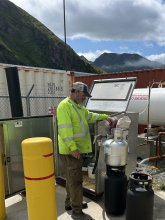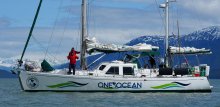Nome, July 2025
This is the big one. From this point forward, provisioning becomes a logistical art form. The Northwest Passage will take us about two months, and while there are a few remote villages along the way, their supplies are limited (and expensive). We’ll make a couple of fuel stops, but we’re aiming to be as self-sufficient as possible so we don’t strain local resources—or our budget.
Diesel Fuel
In the last report, we estimated 1.3 GPH heading up the Inside Passage. That was a rough guess—back then, we were running at various RPM 1500-1900, with added engine time from anchoring, marinas, and the occasional generator use.
After refueling in Juneau, we settled into a more consistent pace: 6 knots at 1550 RPM. From there to Unalaska, we ran 110 engine hours and burned 152 gallons—giving us a confirmed rate of 1.07 GPH. We’re thrilled with that number.
In Nome, we topped off 88 gallons—15 gallons went to the heater/hot water tank, and 73 gallons supported 65 hours of engine time (again at that steady 1550 RPM, ~5.9 knots). We also ran the generator for around 10 hours. After crunching the numbers, we’re consistently seeing about 1.1 GPH.
Here’s the breakdown:
- Yanmar engine estimates:
- Inside Passage → ~1.3 GPH (estimated)
- Juneau → Unalaska → 1.08 GPH
- Unalaska → Nome → 1.12 GPH (some generator time)
- Generator: ~0.5 GPH
- Furnace Tank: 18.6 gallons over 3 weeks (Juneau → Unalaska)
- Furnace Tank: 15 gallons over 3+ weeks (Unalaska → Nome)
- Estimated Heater: ~6 gallons/week during cloudy 48°F weather. We’re budgeting more for colder temps ahead.
One Ocean’s Range Under Power
Even though One Ocean sails like a dream, we can’t always count on wind. Planning our motoring range is critical—not just for the Northwest Passage, but also for future windless zones like the equatorial Atlantic doldrums.
With an average burn rate of 1.1 GPH at 1550 RPM (~6 knots), and three fuel tanks (160 + 60 + 60 gallons), we’ve got 280 gallons total. One of the 60-gallon tanks is our heater tank and will be used last. Thanks to the Skagit Valley College Marine Maintenance Program, we have an updated fuel system allowing us to transfer fuel between tanks and use 100% of the fuel we carry in those three tanks.
We’re setting aside 30 gallons for the heater, leaving 250 gallons for propulsion. After subtracting a 10% reserve, that’s 225 gallons, which gives us:
- 205 engine hours at 1.1 GPH
- ~1,227 nautical miles at 6 knots
That’s more than enough to get us from Nome to Utqiaġvik (Barrow) without sails if needed—and then onto Tuktoyaktuk which is reassuring.

Propane
Onboard One Ocean, propane is just for cooking. Heat and hot water comes courtesy of diesel.
Back in Juneau, after a week of cooking, we refilled using a ½ gallon. With two tanks holding ~8 gallons combined, we’re set for a while. We added a fresh tank in Unalaska and left with two full ones.
Nome’s propane system is a bit... unique. There’s one supplier, and they send your tanks up to the “tank farm.” You can’t go there yourself (not staffed), so you drop the tank off in the morning and pick it up later. Super convenient—except they charge a flat fee. We paid $71, even though the tank still felt over half full. Oh well—remote logistics tax.
Upcoming Passages
Next up: a non-stop 550 NM passage to Utqiaġvik (Barrow). Once we round Cape Hope and Point Lisburne, there’s nowhere to duck in. Fuel stops are limited, and Barrow’s fuel access involves hauling jerry cans by dinghy—not ideal.
From there, it’s another ~550 NM to Tuktoyaktuk, where—good news!—there’s a dock and a truck that delivers fuel right to the boat. With our current range, we’re golden—even if we have to motor the entire stretch.

Things Working Well
While waiting in Nome for the ice to clear in Barrow, we lucked out with beautiful sunny weather—but no shore power (pretty standard from here on). Fortunately, our four LightLeaf 110W solar panels are pulling in ~2 kWh/day, according to our Victron controller.
That was enough to go 3–4 days without the generator. After that, we ran the genset a couple hours a day to keep the batteries happy.
The clouds and rain eventually came in and now we are dependent on the 5.5 KW generator we have in the lazeratte. Happy to report that it is performing well and keeps our batteries happy.
What’s Next
As soon as the ice opens up—we head north. And naturally, we’ll fix whatever new gremlin decides to show up during the next 550 NM ocean hop. 😅
Cheers,
Mike

